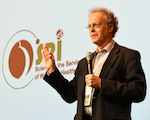The 64th Annual Scientific Meeting of Society of Reproductive Investigation (SRI) was held from 15 – 18 March 2017 in Orlando, United States. The theme of the annual meeting was “D2D: Data to Discovery” which aimed to highlight the power of big data in basic, translational, and clinical research to promote knowledge in reproductive health and medicine.
There were 24 concurrent oral sessions, 3 poster presentation sessions, 12 mini-symposia and 6 pre-congress satellite meetings on specialised topics.

Welcome by SRI President, Yoel Sadovsky, MD
One of the satellite sessions focused on endometrium-related conditions and biology, which was titled Endometriomics in Health and Disease. It delivered in-depth talks on various molecular aspects of endometrium and related disease. In the main programme, there were three sessions dedicated to endometriosis, fibroids, and gyneacology, in which there were 8 talks on endometriosis. Here are some highlights from selected presentations from the meeting:
Addressing neglected diseases: innovative ways to relieve women from the burden of endometriosis
Dr Markus Koch, from Bayer AG delivered a comprehensive update on the Bayer AG’s drug research and development for endometriosis. Dr Koch talked about the drug discovery switch the company is adapting for endometriosis. Given that endometriosis is a chronic inflammatory condition, they are aiming to target key pathways in inflammation and inflammatory pain and leaving hormonal cycle and systemic hormone concentrations untouched. Targeting the inflammatory component of endometriosis could potentially address endometriosis-associated pain for the following reasons:
“Endometriotic lesions within the peritoneal cavity undergo cyclical changes associated with tissue remodelling, cellular stress and even bleeding of the lesions”,
“Endometriosis is a mild, chronic inflammatory disease characterised by increased levels of inflammatory cytokines, prostanoids and ATP in the peritoneal fluid”,
“Endometriosis-associated pain correlates with increased levels of inflammatory cytokines.”
Dr Koch stated that research goals for the drug discovery for endometriosis should include:
- Clinical meaningful reduction of endometriosis associated pain.
- Target population: Young women in reproductive age, non-life threatening disease.
- Safety profile allowing long-term treatment.
- No oestrogen-deprivation linked side-effects.
- Toxicity to reproduction observed only at exposures exceeding human exposure.
- Possibility to use combined oral contraceptives/progestin-only pill.

Delegates networking at the 64th Meeting of the SRI
Drug discovery starts with selection of targets to test, which should be expressed in endometrial disease tissue, have a known role in modulation of pain and/or inflammation in related diseases and not be involved in homeostasis for safety reasons. Then these targets need to be validated in phase II clinical studies to increase confidence in human data. It is important to demonstrate both in vitro and in vivo that the target of interest can be modulated with a relevant outcome and satisfy the safety requirements. The usual time span from target identification to validation can range between 2-4 years, which may lead to a suitable compound that can be tested in humans or not. Dr Koch gave a very nice overview of the animal models and their limitations for profiling the pre-clinical compounds for endometriosis.
Furthermore, he shared Bayer AG’s early drug discovery pipeline for different gynecological disorders including endometriosis, uterine fibroids, polycystic ovary syndrome (PCOS). For endometriosis, they have 3 compounds in phase I and 1 compound in phase II. Dr. Kocher showed some novel data suggesting AKR1C3 as a strong drug target for which the phase I trials have been completed. AKR1C3 has shown to be up-regulated in disease tissue and has a crucial role in intra-tissue steroid and prostaglandin metabolism. Moreover, a compound that is a potent and selective inhibitor of AKR1C3 has been shown to reduce lesions by 70% in a marmoset endometriosis model. Moreover, the AKR1C3 inhibitor combines the local anti-hormone concept with an anti-inflammatory approach without affecting ovarian function. Dr. Koch concluded his presentation with the message that safe relief from endometriosis symptoms should be the main research goal.
Role of the WNT pathway in endometriosis
Dr Maik Obendorf from Bayer AG presented some compelling evidence for potential role of WNT signaling in endometriosis from in vitro and in vivo studies.

A captive audience at the 64th Meeting of the SRI
WNT signaling pathway has important functions in self-renewal of stem cells and has been implicated in growth pathologies such as cancer. Dr Obendorf showed increased expression of several WNT signalling pathway genes including WNT2B, WNT7A, LGR5, RSPO1 and FZD7 in stromal and epithelial cell components of disease tissue. Moreover, overexpression of LGR5 led to increased WNT activity, viability, migration and decreased cell death. Furthermore, in a mouse model of endometriosis, through administration of a WNT signaling inhibitor, a significant reduction in disease burden in by decreasing lesion size and lesion number was observed.
P2X3 – a highly innovative target for the non-hormonal treatment of endometriosis
Dr Davenport from Bayer and Evotec AG showed very nice experimental data to support P2X3 as a potential non-hormonal treatment target option for endometriosis. P2X3 under inflammatory conditions is thought to contribute to central sensitisation, which is a condition of the nervous system that is associated with development and maintenance of chronic pain.
Dr Davenport showed increased expression of P2X3 in nerve fibers of the disease lesions. Moreover, in a rat model, a potent P2X3-selective antagonist was shown to interfere with vicious circle between the nervous and the immune system. Furthermore, in a rat endometriosis-induced model of dyspareunia, this P2X3-selective antagonist demonstrated significant reduction of vaginal hyperalgesia. Robust pharmacological evidence of the P2X3-selective antagonist provides a strong potential for non-hormonal treatment of endometriosis.
An applied system biology approach to study the endometrial receptivity of the transcriptomics of the endometrium: A 15 Year data experience
Dr Horcajadas from the University of Pablo de Olavide in Sevilla, Spain, reflected upon his experience in deciphering the gene expression profile of endometrium, which is the most relevant disease tissue for endometriosis. It is important to understand the expression profile of endometrium in endometriosis cases compared to healthy individuals tocomprehend the functional roles of the genetic risk variants of endometriosis.
Precision medicine and women’s health

Professor Linda Giudice, University of California San Francisco
Professor Linda Giudice (University of California, San Francisco) gave a spectacular talk on precision medicine research in women’s health. She highlighted that disease classifications and treatments are changing such that:
- Disease by location or origin is convenient but limiting.
- Disease classification solely by histology needs to be revisited.
- More refined disease classification needs expanded decision algorithms.
She concluded that in the future, personalised treatment will utilise complex decision algorithms, which integrate genomics, transcriptomics, epigenomics, proteomics, microbiome, exposures, behaviours, informatics and clinical data both cross-sectionally and over the whole life-time of patients to give more precise and effective treatments..
The poster sessions also included some niche research targeting different aspects of endometriosis including;
Genomics and gene-expression of endometriosis:
- Large-scale integrated genome-wide RNA sequencing, miRNA array, and genomic analyses to unravel the functionality of genome-wide association results in endometriosis
- Endometriosis alters expression of genes modulating anxiety, depression and pain in the brain.
- Tissue specific expression analysis in endometriosis by laser capture microdissection.
Ovarian cancer and endometriosis:
- Endometriosis associated risk of ovarian cancer is increased in cases of ovarian but not in DE or peritoneal endometriosis.
- Endometriosis and ovarian cancer: shared genetic risk and common mechanisms.
Inflammation, fibrosis, and pain components of endometriosis:
- Inflammation and fibrosis mediate distinct phenotypic progression in endometriosis.
- The baboon model for investigation of endometriosis-associated pain.
This year, the endometriosis sections in the SRI Annual meeting were dominated by great drug development talks for endometriosis. It is very exciting to see scientific findings in translation steps to clinic, which is the end goal of any research.
About the author

Dr Nilufer Rahmioglu, Wellcome Trust Center for Human Genetics, University of Oxford, United Kingdom
Dr Nilufer Rahmioglu is a senior research scientist, investigating genetic and environmental risk factors of endometriosis and related co-morbidities at the Wellcome Trust Center for Human Genetics, University of Oxford.
Her research involves:
- Elucidation of the underlying genetic mechanisms of endometriosis through genome-wide association studies, transcriptomic and epigenomic profiling of endometrium, fat and endometrial disease tissues,
- Investigation of phenotypic and shared genetic associations between endometriosis and obesity-related traits, gynaecological disorders and other chronic pain conditions,
- Development and maintenance of global consensus on standardised data and sample collection protocols, the WERF endometriosis phenome and biobanking harmonization project (EPHect),
- Establishment of an eastern Mediterranean women’s health study to investigate the influence of the ‘Mediterranean lifestyle’ and the genetic factors on women’s health from this region.

